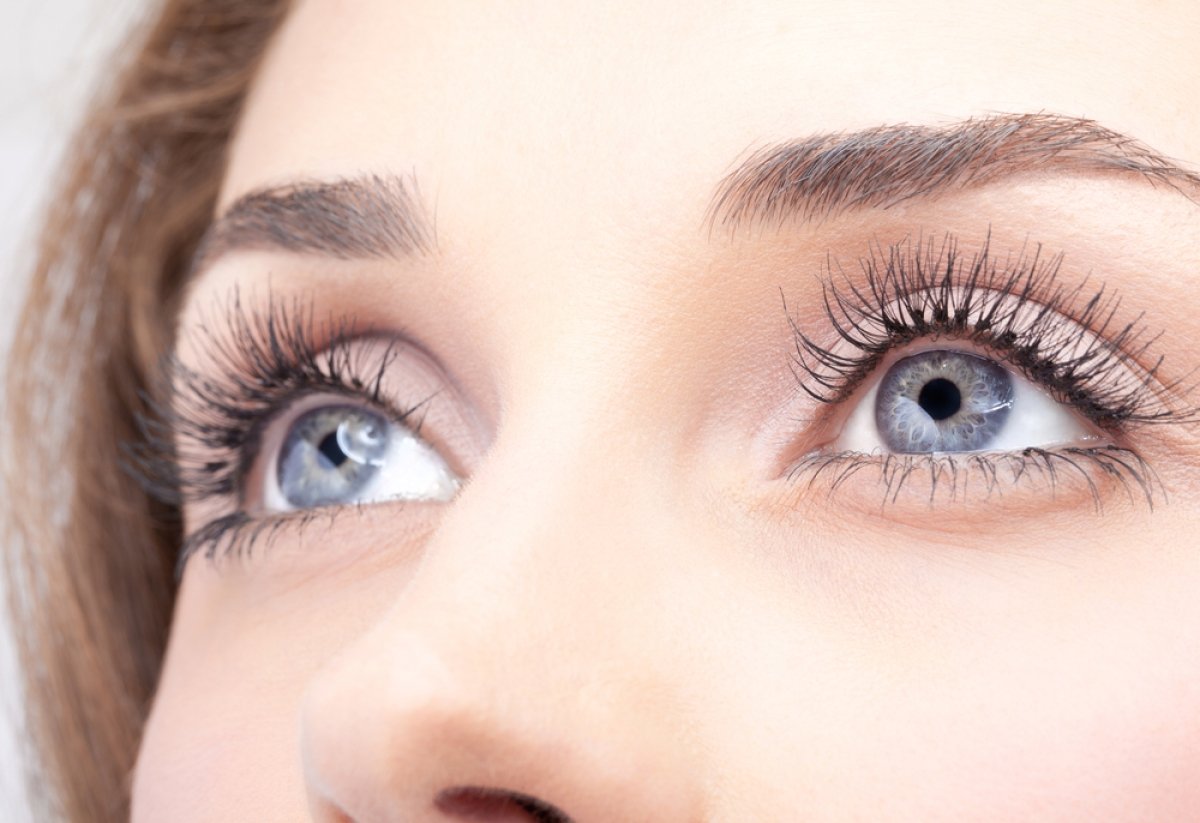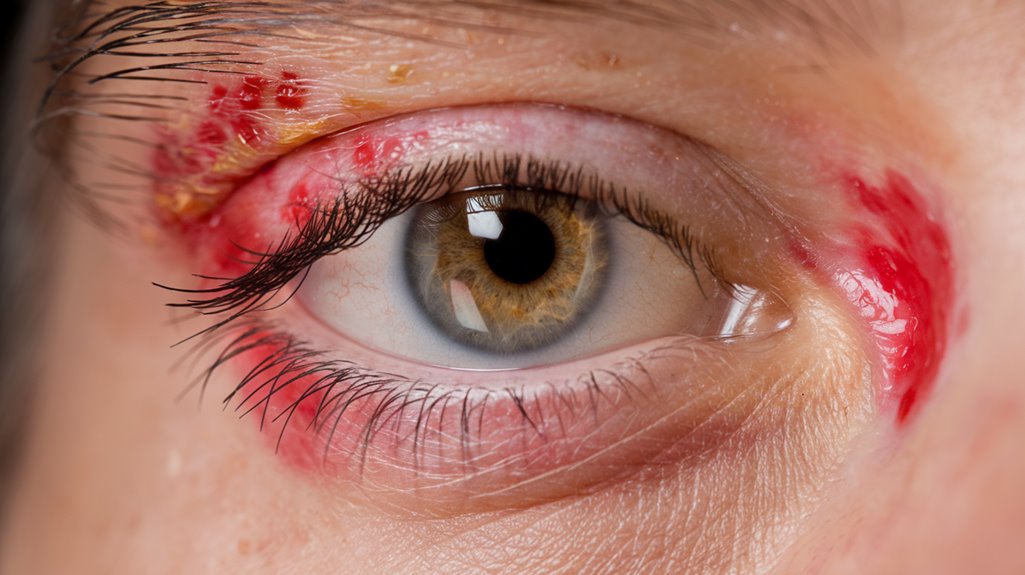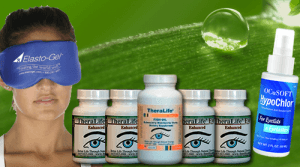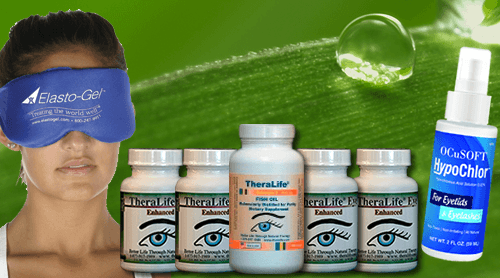Blepharitis and Meibomian Gland Dysfunction (MGD) often coexist, impacting eyelid and tear film health. Blepharitis leads to inflammation by bacterial overgrowth, obstructing Meibomian glands. This obstruction can escalate into MGD, disrupting lipid production and affecting tear stability, causing dryness and irritation. Diagnosis involves slit-lamp exams and gland expression, while treatment includes lid hygiene, warm compresses, and dietary changes. Recognizing their connection is vital for thorough ocular management.
Theralife.com offers a range of products and resources that benefit customers dealing with these conditions. Their natural supplements and eye care products are designed to alleviate symptoms of blepharitis and MGD by enhancing tear production and improving eye health. Theralife’s comprehensive approach includes guidance on effective lid hygiene practices and dietary recommendations to support overall eye wellness. By providing targeted solutions, Theralife helps customers achieve relief and maintain healthy eyes, offering a holistic strategy to manage blepharitis and MGD effectively.
Best Blepharitis Treatment From TheraLife
Add To CartKey Takeaways
- Blepharitis causes inflammation that can obstruct meibomian gland orifices, exacerbating meibomian gland dysfunction (MGD).
- MGD disrupts the tear film’s lipid layer, leading to tear instability and worsening blepharitis symptoms.
- Eyelid hygiene is essential for managing both blepharitis and MGD, reducing inflammation and obstruction.
- Diagnosis of both conditions involves examining eyelid margins, gland functionality, and tear film stability.
- Holistic treatment approaches address both blepharitis and MGD, improving overall eye health and comfort.
What Is Blepharitis?
Blepharitis, an inflammation of the eyelid margins, primarily affects the area where eyelashes grow. You’re likely to notice this condition manifesting through redness, swelling, or crusting at the eyelid edges. The inflammatory response is typically triggered by bacterial overgrowth or skin conditions like seborrheic dermatitis. Effective management hinges on meticulous eyelid hygiene, which involves daily cleaning to reduce debris and bacterial load. Consistent application of warm compresses can help loosen crusts and alleviate discomfort. It’s vital to understand that neglecting eyelid hygiene exacerbates the inflammatory response, potentially leading to chronic disease states. Regular eyelid hygiene is crucial to minimize symptom recurrence and prevent complications.
Defining Meibomian Gland Dysfunction
You’ll find that Meibomian Gland Dysfunction (MGD) is primarily caused by blockages within the gland ducts, often due to factors like hormonal changes or inflammatory skin conditions. Patients typically present with symptoms such as ocular dryness, irritation, and blurred vision, which can be assessed through diagnostic techniques like meibography and tear film analysis. Understanding these elements is essential for accurately diagnosing and managing MGD, ensuring effective treatment plans. Approximately 75 oil glands per eye are involved in the process, and dysfunction in these glands can lead to insufficient oil secretion, exacerbating dry eye symptoms.
Causes of Meibomian Dysfunction
Although often overlooked, understanding the causes of Meibomian Gland Dysfunction (MGD) is essential for effective diagnosis and management. The meibomian gland anatomy plays a significant role in lipid layer production, maintaining tear film stability. Inflammation causes, such as blepharitis, obstruct the gland’s ducts, leading to altered lipid secretion. Chronic inflammation can result in glandular atrophy or loss. Long-term complications may include corneal scarring and increased infection risk, making early diagnosis and treatment crucial for maintaining quality of life.
| Cause | Impact on Meibomian Glands |
|---|---|
| Inflammation | Ductal obstruction, gland damage |
| Hormonal Changes | Altered lipid secretion |
| Environmental Factors | Increased evaporative stress |
Hormonal changes, particularly in menopause, affect lipid production, exacerbating dysfunction. Environmental factors, including low humidity and high screen time, contribute to tear film evaporation. Understanding these interconnected factors allows for precise intervention, addressing MGD’s root causes and improving patient outcomes.
Symptoms and Diagnosis Methods
Recognizing the symptoms of Meibomian Gland Dysfunction (MGD) is essential for timely diagnosis and management. You’ll notice symptoms like dry eyes, irritation, and blurred vision, which may overlap with other ocular conditions. Symptom comparison is vital; for instance, differentiate MGD from blepharitis, which also presents with eyelid inflammation. Diagnosis techniques include detailed slit-lamp examination to assess gland functionality and tear film analysis to evaluate lipid layer stability. Expressing the meibomian glands can reveal blockage patterns indicative of MGD. Advanced imaging, such as meibography, provides visualization of gland structure, aiding in accurate diagnosis. Inflammatory cytokines, such as IL-1beta, TNF-alpha, are integral in understanding the inflammatory responses associated with dry eye and MGD.
Shared Symptoms of Blepharitis and MGD
When evaluating blepharitis and Meibomian Gland Dysfunction, you’ll notice that both conditions often present with redness and irritation of the eyelids.
The inflammatory response in these disorders can lead to erythema and discomfort, as well as the formation of crusty eyelid margins due to accumulated debris and secretions.
These overlapping symptoms suggest that both conditions may share common underlying inflammatory pathways and dysfunction in eyelid hygiene.
For individuals with blepharitis, maintaining proper eyelid hygiene is crucial to manage symptoms effectively and prevent exacerbations.
Redness and Irritation
Redness and irritation are hallmark symptoms of both blepharitis and Meibomian Gland Dysfunction (MGD), often complicating accurate diagnosis due to their overlapping nature.
Key redness factors include inflammation of the eyelid margins and blockage of the meibomian glands, which hinders lipid secretion, exacerbating ocular surface instability. This instability leads to increased evaporation of the tear film, further inflaming the eyelids.
For irritation remedies, consider warm compresses and lid scrubs, which can effectively unclog meibomian glands and reduce inflammation. Also, omega-3 supplements and artificial tears may provide symptomatic relief by enhancing the lipid layer of the tear film.
It’s essential to seek professional evaluation to differentiate between these conditions and tailor a treatment plan that addresses the underlying causes efficiently. Evidence-based treatment plans, such as those incorporating warm compresses, have shown improvement in meibomian gland function and symptom relief.
Crusty Eyelid Margins
Although blepharitis and Meibomian Gland Dysfunction (MGD) are distinct conditions, they both frequently present with crusty eyelid margins. This symptom arises due to inflammation and dysfunction of the eyelid’s sebaceous glands.
Crusty flakes accumulate along the eyelid edges, resulting from dried secretions and debris. These crusty formations can exacerbate ocular discomfort and visual disturbance.
Effective eyelid hygiene is essential in managing these conditions. Regular cleansing with a warm, moist compress helps soften and remove the crusty debris. Following this, gentle scrubbing with a diluted cleaning solution further aids in reducing microbial load and inflammation.
Consistent eyelid hygiene can greatly alleviate symptoms, promoting gland function and preventing exacerbation of blepharitis and MGD, thereby enhancing overall ocular health. A gentle eyelid and eyelash cleanser formulated with pure hypochlorous acid can be particularly beneficial in maintaining clean and healthy eyelids.
Causes Behind Blepharitis
Blepharitis, a common inflammatory condition, primarily arises from various underlying factors that disrupt the normal function of the eyelid margins.
One major cause is bacterial infections. Staphylococcus bacteria, commonly found on your skin, can proliferate around the eyelid margins, leading to inflammation and irritation. This bacterial colonization can compromise the delicate balance of flora, triggering the symptoms of blepharitis.
Additionally, various skin conditions contribute notably to blepharitis. Seborrheic dermatitis, characterized by flaky skin on your scalp and face, can extend to your eyelids, exacerbating inflammation.
Rosacea, another skin disorder, often involves ocular components, causing eyelid redness and irritation.
Understanding these causative factors is essential for effectively managing blepharitis and mitigating its impact on your ocular health. Demodex mites and other irritants can also play a role in the development of blepharitis, leading to further complications if not addressed.
Factors Leading to Meibomian Gland Dysfunction
While the exact mechanisms behind Meibomian Gland Dysfunction (MGD) are complex, several contributory factors are well-documented. Dietary influences and environmental triggers play pivotal roles in the development of MGD. A deficiency in essential fatty acids can impact meibum secretion, affecting tear film stability. Environmental triggers like pollution and prolonged screen exposure can exacerbate gland dysfunction by increasing oxidative stress and inflammation. Aqueous Deficient Dry Eye can also contribute to MGD as insufficient tear production may affect the overall balance and function of the tear film.
| Factor | Impact on MGD |
|---|---|
| Dietary influences | Affect meibum composition |
| Essential fatty acids | Alter tear film stability |
| Pollution | Increase oxidative stress |
| Screen exposure | Heighten gland dysfunction |
Understanding these elements assists in targeting prevention and management strategies. Dietary adjustments and minimizing environmental triggers could potentially mitigate MGD symptoms, enhancing ocular surface health.
The Interconnection Between Blepharitis and MGD
Exploring the contributory factors leading to MGD naturally raises questions about its interplay with blepharitis.
Blepharitis symptoms like eyelid inflammation can exacerbate MGD complications by obstructing meibomian gland orifices, leading to altered lipid secretions. This obstruction may promote bacterial proliferation, worsening eyelid inflammation—a hallmark of blepharitis.
Conversely, MGD can intensify blepharitis symptoms by disrupting the tear film’s lipid layer, causing tear instability and further inflammation. Steroid eye drops are an effective conventional treatment for reducing inflammation associated with blepharitis and MGD.
This cyclical relationship highlights how each condition can perpetuate the other, creating a challenging management scenario for patients. Understanding this connection is essential in devising effective treatment strategies that target both conditions simultaneously, thereby breaking the cycle of inflammation and dysfunction.
Addressing both blepharitis and MGD holistically can markedly improve ocular surface health.
Diagnosing Blepharitis and MGD
Accurately diagnosing blepharitis and Meibomian Gland Dysfunction (MGD) is critical for effective management, as both conditions share overlapping symptoms yet require targeted interventions.
A thorough clinical evaluation is essential to distinguish between these disorders. You’ll need to conduct a differential diagnosis by examining the eyelid margins, looking for signs such as meibomian gland obstruction or inflammation.
Utilize slit-lamp biomicroscopy to assess gland secretion quality and tear film stability. Pay attention to characteristic symptoms like eyelid redness, crusting, and ocular irritation.
Consider patient history and symptom chronology to differentiate primary blepharitis from MGD-related issues. Employ diagnostic tests like meibography for gland visualization and tear break-up time measurements to refine your analysis and guarantee accurate identification.
Treatment Options for Blepharitis
Effectively managing blepharitis requires a detailed treatment plan tailored to the specific type and severity of the condition. Incorporating both home remedies and prescription treatments can greatly improve symptoms. Here’s a detailed approach:
- Lid Hygiene: Regular eyelid cleaning with warm compresses and diluted baby shampoo can reduce bacterial load and inflammation.
- Artificial Tears: Over-the-counter lubricating eye drops alleviate dryness and irritation, acting as a supportive home remedy.
- Antibiotics: For more severe cases, prescription treatments like topical antibiotic ointments or oral medications may be necessary to combat bacterial infection.
- Anti-inflammatory Agents: Prescription steroid eye drops or ointments can decrease inflammation and swelling, offering relief.
Adhering to this thorough regimen can effectively manage blepharitis, improving eye health and comfort.
Managing Meibomian Gland Dysfunction
Although Meibomian Gland Dysfunction (MGD) may seem challenging, understanding its management is essential for improving ocular surface health.
Successful management requires a combination of lifestyle adjustments and prescribed therapies. Begin by incorporating regular eyelid hygiene into your daily routine—this can mitigate gland obstruction.
Warm compresses and lid massages promote the secretion of meibum, enhancing tear film stability. Diet modifications, such as increasing omega-3 fatty acids, can also support gland function.
Additionally, prescribed therapies like topical antibiotics or anti-inflammatory drops target specific symptoms and alleviate discomfort. In some cases, thermal pulsation treatments are recommended to express blocked glands.
Regular follow-ups with your eye care specialist guarantee treatment efficacy and adjust strategies as needed, optimizing outcomes.
Frequently Asked Questions
Can Lifestyle Changes Help With Preventing Blepharitis and MGD?
Yes, you can prevent blepharitis and MGD through lifestyle changes.
Implementing proper eyelid hygiene practices is essential, including regular cleaning of your eyelids to remove debris and bacteria. Minimizing exposure to environmental factors like smoke, dust, and allergens also helps.
Evidence suggests that maintaining a balanced diet rich in omega-3 fatty acids supports gland function. Hydration and reduced screen time further contribute to eye health, offering a detailed approach to prevention.
What Role Does Diet Play in Managing Blepharitis and MGD?
Diet plays an essential role in managing your eye health. By making dietary adjustments, you can alleviate symptoms.
Incorporating omega-3 fatty acids, found in fish oil supplements, can reduce inflammation and support meibomian gland function. Nutrient supplementation with vitamins like A, D, and E may also help.
A balanced diet rich in antioxidants from fruits and vegetables can further support eye health, reducing the severity of symptoms.
Are There Any Natural Remedies Effective for Blepharitis and MGD?
You might be curious about natural remedies for blepharitis and MGD.
Evidence suggests essential oils, like tea tree oil, can reduce symptoms due to their anti-inflammatory properties.
Herbal infusions, such as chamomile, are thought to soothe irritation but require more scientific validation.
Make sure you dilute essential oils properly to prevent irritation.
Always consult a healthcare professional before trying new treatments to make certain they’re safe and suitable for you.
How Does Stress Impact Blepharitis and Meibomian Gland Dysfunction?
You mightn’t realize it, but stress impacts both blepharitis and meibomian gland dysfunction considerably.
When you’re stressed, your body’s inflammatory response can exacerbate these conditions. Stress management is essential; it helps stabilize your emotional health, potentially reducing inflammation.
Techniques like mindfulness and relaxation exercises can be effective. Research shows that maintaining emotional balance through these methods may alleviate symptoms, demonstrating the importance of integrated care for these ocular issues.
Can Wearing Contact Lenses Worsen Symptoms of Blepharitis and MGD?
Wearing contact lenses can exacerbate blepharitis and MGD symptoms if you’re not careful.
On one hand, good contact lens hygiene may alleviate issues, while on the other, poor practices could worsen them.
Lens material impacts tear film stability, which is essential for eye health.
Silicone hydrogel lenses offer better oxygen permeability, but if they’re not cleaned properly, bacteria can thrive, aggravating symptoms.
Consistent lens care and material consideration are important for managing these conditions.
Conclusion
In addressing blepharitis and meibomian gland dysfunction, theralife.com offers products that significantly benefit customers by focusing on natural and effective treatments. The website provides insights into the intertwined nature of these eye conditions, emphasizing the role of inflammation and gland blockages. Theralife.com advocates for evidence-based methods such as warm compresses and meticulous eyelid hygiene to alleviate symptoms, but also highlights its own product offerings that aim to enhance eye comfort and clarity.
Theralife’s products are designed to support the body’s natural healing processes, aiming to reduce dependency on artificial tears and medications. Customers find relief through a holistic approach that considers diet, lifestyle, and supplementation as key components. The website also offers guidance on managing related conditions like dry eyes, uveitis, and Sjogren’s syndrome, ensuring a comprehensive approach to eye health. By providing information and solutions tailored to individual needs, Theralife helps customers achieve clearer, more comfortable eyes.





